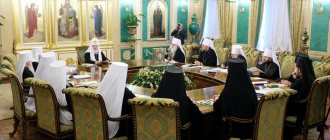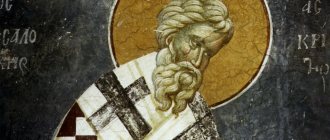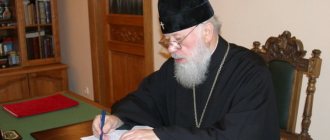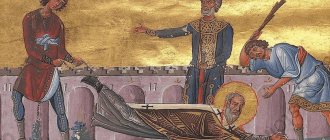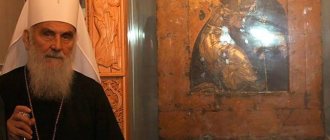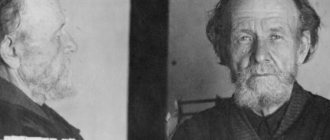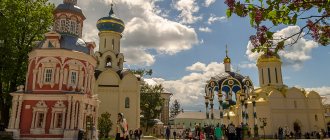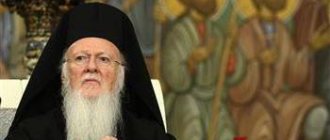What is the hierarchy of the Russian Orthodox Church among clergy
In fact, the church has a rather complex structure and hierarchy. Each clergyman fulfills his role and takes his assigned place in this system.
The scheme of the Orthodox Church has three levels, which were created at the very beginning of the birth of the Christian religion. All servants are divided into the following categories:
- Deacons.
- Priests.
- Bishops.
In addition, they are divided into “black” and “white” clergy. “Black” includes monks, and “white” includes lay clergy.
What does the word "patriarch" mean?
The word consists of two Greek roots: father and dominion, beginning, power. In public life, the word “patriarch” serves to designate a person outstanding in any professional field and is used in a figurative sense. However, in the Church this term always has a completely different meaning.
Firstly, this is the name given to some Old Testament saints who not only participated in the history of salvation, but were also the direct ancestors of the Savior. The ancient patriarchs are also called ancestors or forefathers; Among them, Abraham, Isaac and Jacob are especially famous.
And secondly, the heads of some Orthodox local Churches are called patriarchs. In this meaning, the word “patriarch” does not mean a separate, highest rank of the hierarchy of the priesthood, but a special church status and title. It is assigned by the Church to the most authoritative bishop, who, as a rule, heads the main see of the country.
Structure of the Russian Orthodox Church - diagram and description
Due to some complexity of the church structure, it is worth considering in more detail, for a deep understanding of the algorithms of the work of priests.
Bishop titles
These include:
- Patriarch: the lifelong main title of the leader of the Russian Orthodox Church, at the moment in Rus' this is Kirill.
- Vicar: the bishop's right hand, his deputy, but he does not have his own diocese and cannot manage the bishop's diocese.
- Metropolitan: the governor who leads the metropolitan areas, including those outside the Russian Federation.
- Archbishop: The rank of senior bishop, considered an honorary title.
- Bishop: The third level of priesthood in the Orthodox hierarchy, often with the rank of bishop, governs a diocese and is appointed by the Holy Synod.
Titles of priests
The priests are divided into “black” and “white”.
Consider the “black” clergy:
- Hieromonk: a monk-clergyman, it is customary to address him with the words: “Your Reverence.”
- Hegumen: head (abbot) of a monastery. Until 2011 in Russia, this title was honorary and did not necessarily correspond to the post of head of any monastery.
- Archimandrite: the highest rank for a clergyman who has taken monastic vows. He is often the abbot of large monastic monasteries.
The “white” ranks include:
- Protopresbyter: the highest rank of the Russian Orthodox Church in its “white” part. Given as a reward for special service in some cases and only at the request of the Holy Synod.
- Archpriest: senior priest, the wording can also be used: senior priest. Most often, the archpriest presides over a church. You can receive such a position no earlier than five years of faithful service upon receipt of the pectoral cross and no earlier than ten years after consecration.
- Priest: junior rank of clergy. The priest may be married. It is customary to address such a person as follows: “Father” or “Father, …”, where after the father comes the name of the priest.
Titles of deacons
Next comes the level of deacons, they are also divided into “black” and “white” clergy.
List of "Black" clergy:
- Archdeacon: the senior rank among deacons in a monastic monastery. It is given for special merits and length of service.
- Hierodeacon: priest-monk of any monastery. You can become a hierodeacon after the sacrament of ordination and tonsure as a monk.
"White":
- Protodeacon: the main diocesan deacon; like the archdeacon, it is customary to address him with the words: “Your high gospel.”
- Deacon: a priest who stands at the very beginning of the hierarchy of the Russian Orthodox Church. These are assistants for the rest of the higher ranks of clergy.
HIGH GOVERNANCE OF THE LOCAL CHURCH
adopted by the Council of Bishops in 2000, the “Charter of the Russian Orthodox Church” proclaims the Local Council (II 1) composed of bishops, clergy and laity as the body of the highest church authority, and the Council of Bishops (III 1) as the body of the highest church government.
The Charter recognizes the Local Council as the supreme authority in the field of doctrine and canonical structure of the Russian Orthodox Church. In contrast to the provisions of the 1988 Charter, the timing of convening the Local Council is not regulated by the Charter itself - it is left to the Bishops’ Council to make the appropriate decision (II 2). In exceptional cases, the Local Council may be convened by the Patriarch of Moscow and All Rus' or the Locum Tenens and Priest. Synod (Ibid.).
The Local Council consists of bishops, representatives of the clergy, monastics and laity, elected in the number and order determined by the Council of Bishops. The statute assigns responsibility for the preparation of the Local Council to the Council of Bishops. If the Local Council is convened by the Patriarch or the Locum Tenens and the Priest. By the Synod, proposals on the program, agenda, regulations of meetings and structure of the Local Council are approved by the Council of Bishops (Ibid.).
The members of the Council are diocesan and vicar bishops of the Russian Church according to their position. The procedure for electing representatives from the clergy, monastics and laity to the Council and their quota are established by the Council of Bishops, and in exceptional cases by the Priest. Synod with subsequent approval by the Council of Bishops (II 3, 4).
The powers of the authority of the Local Council (II 5) basically repeat the powers set out in the Charter of 1988 (II 5).
The Chairman of the Council is His Holiness the Patriarch of Moscow and All Rus', and in the absence of the Patriarch, the Locum Tenens of the Patriarchal Throne. The quorum of the Council consists of 2/3 of its members, including 2/3 of the bishops of the total number of hierarchs who are members of the Council. The Local Council elects the cathedral presidium, secretariat and forms working bodies. The Presidium of the Council consists of a chairman (Patriarch or Locum Tenens) and 12 members in the rank of bishop (in the Charter of 1988 - 8). The Presidium presides over the meetings of the Council. The Secretariat of the Council consists of a secretary in the rank of bishop and two assistants - a clergyman and a layman. The Secretariat is responsible for providing members of the Council with working materials and for maintaining minutes of meetings. The Presidium, the secretary and the chairmen of the working bodies make up the Cathedral Council, which is the governing body of the Cathedral. Its competence includes consideration of emerging issues on the agenda and making proposals on the procedure for their study by the Council, coordination of all activities of the Council, consideration of procedural and protocol issues, administrative and technical support for the normal activities of the Council.
The bishops who are members of the Council constitute the Bishops' Conference. The regulations on the Bishops' Conference repeat the corresponding section of the Charter of 1988 (II 13).
The Council of Bishops is the highest body of the hierarchical administration of the Russian Orthodox Church and consists of diocesan bishops, as well as suffragan bishops who head synodal institutions and Theological Academies or have canonical jurisdiction over the parishes under their jurisdiction. All other suffragan bishops may participate in meetings of the Council of Bishops without the right to a casting vote (III 1).
The Council of Bishops is convened by the Patriarch of Moscow and All Rus' or the Locum Tenens and Priest. Synod at least once every 4 years, as well as on the eve of the Local Council and in exceptional cases (III 2). At the suggestion of the Patriarch and Priest. An extraordinary Council of Bishops may be convened by the Synod or 1/3 of the members of the Council - diocesan bishops. Responsibility for the preparation of the Council of Bishops lies with the Priest. Synod.
Decisions at the Council of Bishops are made by a majority of votes, with the exception of special cases specified by the regulations. If there is a tie in an open vote, the vote of the chairman gives the upper hand. If there is a tie in the case of a secret ballot, a repeat vote is held. All official documents of the Council are signed by the Patriarch or Locum Tenens, as well as members of the presidium and the secretary. The resolutions of the Council come into force immediately after their adoption (II 17-19).
The Charter assigns the following responsibilities to the Council of Bishops: maintaining the purity of the Orthodox Church. doctrines and norms of Christ. morality; adoption of the Charter of the Russian Orthodox Church and introduction of amendments and additions to it; preservation of the dogmatic and canonical unity of the Russian Orthodox Church; resolving fundamentally important theological, canonical, liturgical and pastoral issues, canonization of saints and approval of liturgical rites; competent interpretation of the holy canons and other church laws; expression of pastoral concern for contemporary issues; determining the nature of relations with the government. organs; maintaining relations with Local Orthodox Churches; the creation, reorganization and liquidation of self-governing Churches, Exarchates and dioceses, as well as the determination of their boundaries and names; creation, reorganization and liquidation of synodal institutions; approval of the procedure for owning, using and disposing of the property of the Russian Orthodox Church (III 4).
On the eve of the Local Council, the Council of Bishops makes proposals on the agenda, program, regulations of meetings and structure of the Council, as well as on the procedure for electing the Patriarch of Moscow and All Rus', if such an election is proposed. The Council of Bishops is entrusted with monitoring the implementation of the decisions of the Local Council; judgment about the activities of the Priest. Synod and synodal institutions; approval, repeal and amendment of legislative acts of the Holy. Synod; creation and abolition of church governing bodies; establishing a procedure for all ecclesiastical courts; review of financial reports submitted to the Holy. Synod, and approval of the principles for planning upcoming church-wide income and expenses; approval of new church-wide awards. In accordance with the current Charter, the Council of Bishops is the ecclesiastical court of the highest instance (III 5).
The Chairman of the Council of Bishops is the Patriarch or Locum Tenens (III 6). The Presidium of the Council of Bishops is not elected; it is composed of the Holy Hierarch. Synod. The Presidium is responsible for the leadership of the Council; it proposes the agenda, program and regulations of the Council, makes proposals on the procedure for studying emerging problems by the Council, and considers procedural and protocol issues. The Secretary of the Council of Bishops is elected from among the members of the Synod and is responsible for providing the Council with the necessary working materials and for maintaining minutes (III 7).
Meetings of the Council are chaired by the chairman or, at his proposal, by one of the members of the Priest. Synod. Theologians, specialists, observers and guests may be invited to individual meetings of the Council without the right to a casting vote. The degree of their participation in the work of the Council is determined by the regulations. Decisions at the Council are made by a simple majority of votes by open or secret ballot, except for cases specifically provided for by the regulations. As at the Local Council, when during an open vote the votes are divided equally, the vote of the chairman is decisive, and in the event of a tie during a secret ballot, a repeat vote is held. The quorum of the Council consists of 2/3 of the hierarchs - its members. The resolutions of the Council of Bishops come into force immediately after their adoption (III 10-15; this part of the current Charter basically repeats the 1988 Charter).
The main innovation of the provisions of the 2000 Charter regarding Local and Bishops’ Councils lies in such a redistribution of their powers, when the Bishops’ Council, while remaining a lower authority in relation to the Local Council, nevertheless ceases to be a body subordinate to it in everything, as it was previously (Charter, 1988. III 4). He becomes the highest judicial authority of the Russian Orthodox Church (III 5; 4 b, c), he alone finally adopts the Charter and makes changes to it, only he is authorized to make final decisions on matters of church administration, with the exception of the election of His Holiness the Patriarch of Moscow and All Rus', and only those decisions of the Council of Bishops are subject to approval by the Local Council, which are doctrinal or canonical in nature (II 5 g). That. The current Charter resolves the problem of canonically legitimate clarification of the competence of the Bishops' and Local Councils. In the Charter of 1988, the Council of Bishops was placed in a subordinate position in relation to the Local Council, despite the fact that canonically the Council of Bishops has undiminished full power in the Local Church.
There are indisputable canonical grounds for such a redistribution of the functions of the Local and Bishops' Councils. The canons, in fact, know exclusively the council of bishops of the region, that is, the Local Church. So, the 19th is right. The Fourth Ecumenical Council reads: “Therefore, the holy council, in accordance with the rules of the holy fathers, determined that in each region the bishops would gather together twice a year, where the bishop of the metropolis would appoint, and correct everything that was revealed.” 8th rights. The Trullo Council changed the frequency of convening Councils, but did not affect their composition: “But since, due to barbarian raids and other random obstacles, the primates of the Churches do not have the opportunity to convene councils twice a year, it is reasoned: for those who are likely to arise church affairs, in each region, the council of the above-mentioned bishops should be in every possible way once a summer.” The same exclusively bishop composition of the Council is provided for by the VII Ecumenical. 6 and Carth. 14.
To Karth. 18 (27) we are talking about the fact that at the Councils of the African Church, the episcopate of which was especially numerous (many hundreds of bishops), each metropolis was represented not by all bishops, but by special representatives, and certainly in the episcopal rank: “Confirm It is fitting at this holy council that, according to the rules of the Council of Nicaea, for the sake of church affairs, which are often postponed to the detriment of the people, a council should be convened every year, to which all those occupying the first departments in the regions would send from their councils two, or as many as they choose, bishops, as locums, so that the assembly thus constituted may have complete authority.” The rules of Carth also speak of the exclusively episcopal composition of the Councils. 76 (87), 127 (141, 142).
40th rights. The Council of Laodicea says: “It is not proper for bishops who are called to a council to be careless, but to go and admonish, or to be admonished for the improvement of the church, and so on. If he neglects it, he will blame himself: unless he stays because of illness.” Thus, wherever the canons talk about the Council, the Council of Bishops is meant. The canons do not provide for Councils in which presbyters, deacons and laity would participate.
Since the validity of the decisions of the Local Council is conditioned by the sanction on them from the episcopate of the Local Church participating in the Council, in the current Charter the Bishops' Conference can cancel a decision made by the full composition of the Local Council not by the votes of 2/3 of the bishops present, as was provided for by the Charter of 1988 (II 15), but by a simple majority (II 13). The previous situation did not give the episcopate complete control over the course of conciliar actions. After all, 2/3 of the bishops could not cancel a decision made by the Council as a whole, in accordance with it, even if the decision made at a meeting of the Local Council was passed by a simple majority of at least 1 vote. Thanks to the correction made, the episcopate regained canonically justified control over the outcome of the actions of the Local Council (see also in Art. Council of Bishops).
The head of the Russian Orthodox Church bears the title “His Holiness Patriarch of Moscow and All Rus'.” The Patriarch has primacy of honor among the episcopate of the Russian Orthodox Church and is accountable to the Local and Bishops' Councils. The name of the Patriarch of Moscow and All Rus' is exalted during divine services in all churches of the Russian Orthodox Church.
The Patriarch has care for the internal and external welfare of the Russian Orthodox Church and governs it together with the Holy Father. Synod, being its chairman. Relations between His Holiness the Patriarch and the Holy. The Synod “is determined by the 34th rule of St. Apostles and the 9th rule of the Council of Antioch" (IV 5; Charter, 1988. IV 5). The Patriarch, together with the Synod, convenes Councils of Bishops, in exceptional cases - Local Councils, as well as meetings of the Holy. Synod and presides over them (IV 6).
Listing the personal duties of His Holiness the Patriarch, the current Charter emphasizes that he fulfills them, “exercising his canonical authority” (IV 7; cf. Charter, 1988. IV 7). They include the following: The Patriarch is responsible for the implementation of the decisions of the Councils and Holy Orders. Synod; presents reports to the Councils on the state of the Russian Church during the inter-Council period; supports the unity of the hierarchy of the Russian Orthodox Church; carries out supervisory supervision of all synodal institutions; addresses with pastoral messages to the entire Fullness of the Russian Church; signs church-wide documents after their approval by the Synod; exercises executive and administrative powers to manage the Moscow Patriarchate; communicates with the Primates of the Orthodox Church. Churches in pursuance of the resolutions of the Councils or Synod, as well as on their own behalf; represents the Russian Orthodox Church in relations with the highest government bodies. power and management (these responsibilities are mainly contained in the 1988 Charter); “has a duty of intercession and “sorrow” to state authorities both on the canonical territory and beyond its borders” (IV 7 k), approves the statutes of self-governing Churches, Exarchates and dioceses; accepts appeals from diocesan bishops of self-governing Churches (IV 7 l, m).
The Patriarch also issues decrees on the election and appointment of diocesan bishops, heads of synodal institutions, vicar bishops, rectors of theological schools and other officials appointed by the Synod.
He has care for the timely replacement of bishop's departments; entrusts bishops with temporary management of dioceses in the event of long-term illness, death or being under ecclesiastical court of diocesan bishops; monitors the fulfillment by bishops of their archpastoral duty to care for the dioceses; has the right of visitation - visiting, if necessary, all dioceses of the Russian Orthodox Church; gives fraternal advice to bishops both regarding their personal lives and regarding the performance of their archpastoral duty. His Holiness the Patriarch accepts complaints against bishops and gives them action; awards bishops with established titles and highest church honors; awards clergy and laity with church awards; approves the awarding of academic degrees and titles; has care for the timely production and consecration of St. peace for general church needs.
The Patriarch of Moscow and All Rus' is the diocesan bishop of the Moscow diocese, consisting of the city of Moscow and the Moscow region. The Patriarch is assisted in the management of the Moscow diocese by the Patriarchal Viceroy with the rights of a diocesan bishop with the title “Metropolitan of Krutitsky and Kolomna” (IV 9; Charter, 1988. IV 9).
The Patriarch of Moscow and All Rus' is the sacred archimandrite of the Holy Trinity Sergius Lavra, a number of other monasteries and governs all church stauropegies (IV 10; Charter, 1988. IV 10). The formation of stauropegial monasteries and metochions in the Moscow diocese is carried out according to the decrees of the Patriarch of Moscow and All Rus'. The formation of stauropegies within other dioceses is carried out with the consent of the diocesan bishop by decision of the Patriarch of Moscow and All Rus' and the Holy. Synod (IV 10).
The rank of Patriarch is for life. The right to try the Patriarch, as well as the decision on his retirement, belongs to the Council of Bishops (IV 12; in the Charter of 1988 (IV 12) - to the Local Council).
In the event of the death of the Patriarch, his retirement or any other reason making it impossible for him to fulfill the patriarchal position, the Charter provides for the institution of locum tenens. The procedure for electing a Locum Tenens basically follows the procedure specified in the 1988 Charter: Priest. The Synod, chaired by the oldest permanent member by consecration, immediately elects the Locum Tenens of the Patriarchal Throne from among the permanent members (IV 13). During the period of interpatriarchate, the Russian Orthodox Church is governed by a Synod chaired by the Locum Tenens; the name of the Locum Tenens is exalted during services in all churches of the Russian Orthodox Church. The locum tenens fulfills the duties of the Patriarch of Moscow and All Rus' in full, with the exception of the right to award bishops with titles and highest church honors. The Metropolitan of Krutitsky and Kolomna at the same time enters into independent administration of the Moscow diocese (IV 15). No later than 6 months after the vacancy of the Patriarchal Throne, the Locum Tenens and the Synod are obliged to convene a Local Council to elect a new Patriarch (IV 16).
The section on the qualities that a candidate for Patriarch must have, listed in the current Charter, repeats the corresponding section of the 1988 Charter (IV 17).
Priest The Synod, headed by the Patriarch or Locum Tenens, is the governing body of the Russian Orthodox Church in the period between Councils of Bishops. The Synod is responsible to the Council of Bishops and, through the Patriarch, submits to it a report on the activities during the inter-Council period (V 1).
Priest The Synod consists of a chairman - the Patriarch or Locum Tenens, 7 permanent (in the 1988 Charter - 5) and 5 temporary members - diocesan bishops. The permanent members are: by department - Metropolitans of Kiev and All Ukraine; St. Petersburg and Ladoga; Krutitsky and Kolomensky; Minsky and Slutsky (Patriarchal Exarch of All Belarus); Chisinau and all Moldova; by position - chairman of the Department for External Church Relations and manager of the affairs of the Moscow Patriarchate. Temporary members are called to attend one session, according to the seniority of the episcopal consecration, 1 from each group into which the dioceses are divided. A bishop cannot be summoned to the Synod until the expiration of his 2-year term of administration of a given diocese. The synodal year is divided into 2 sessions: summer (March-Aug.) and winter (September-February).
Ruling bishops, heads of synodal institutions and rectors of Theological Academies may be present at meetings of the Synod with the right of an advisory vote when considering matters concerning the dioceses, institutions, schools they govern or their exercise of church-wide obedience.
The quorum of the Synod consists of 2/3 of its members. Meetings of the Synod are convened by the Patriarch (Locum Tenens). As a rule, the meetings of the Synod are closed. If the Patriarch according to k.-l. due to temporary inability to exercise chairmanship duties in the Synod, the duties of the chairman are performed by the oldest permanent member of the Synod by consecration. In this case, the temporary chairman of the Synod does not become a canonical Locum Tenens (V 14). The secretary of the Synod is the manager of the affairs of the Moscow Patriarchate.
Matters in the Synod are decided by the general consent of all members participating in the meeting or by a majority vote. In case of equality of votes, the chairman's vote is decisive. None of the members of the Synod present at the meeting may abstain from voting. In case of disagreement with the decision made, a member of the Synod may submit a separate opinion, which must be stated at the same meeting outlining the reasons and then submitted in writing no later than 3 days from the date of the meeting. Individual opinions do not stop the implementation of the decision.
The chairman does not have the right to remove items proposed on the agenda from discussion, interfere with their resolution or suspend their implementation. However, in cases where the Patriarch recognizes that the decision made will not bring benefit and benefit to the Church, he lodges a protest, which must be made at the same meeting and set out in writing within 7 days. After this period, the case is again considered by the Holy. Synod. If the Patriarch does not agree with the new decision of the case, then it is suspended and referred to the Council of Bishops for consideration. If it is impossible to postpone the matter and a decision must be made immediately, the Patriarch acts at his own discretion. Accepted thus. the decision is submitted to the extraordinary Council of Bishops, on which the final resolution of the issue depends (V 20; repeats the corresponding provision of the 1988 Charter). This right is granted only to the Patriarch, but not to the Locum Tenens.
Definitions of the Holy The Synod comes into force after they are signed and are not subject to revision, except in cases where new data changes the essence of the matter. The Chairman of the Synod exercises supreme supervision over the implementation of adopted resolutions (V 23, 24).
The duties of the Priest. Synod (V 25; basically repeating the Charter of 1988) includes: care for the intact storage and interpretation of the Orthodox Church. faith, norms of Christ. morality and piety; serving the internal unity of the Russian Orthodox Church; maintaining unity with other Orthodox Christians. Churches; organizing the internal and external activities of the Church and resolving issues of general church significance arising in connection with this; interpretation of canonical decrees and resolution of difficulties associated with their application; regulation of liturgical issues; issuing disciplinary decisions; assessment of the most important events in the field of interchurch, interconfessional and interreligious issues. relationships; maintaining interfaith and interreligious connections both on the canonical territory of the Moscow Patriarchate and beyond; coordination of the actions of the Fullness of the Russian Church in its efforts to achieve peace and justice; expression of pastoral concern for social problems; sending messages to all children of the Russian Orthodox Church; maintaining proper relations between the Church and the state in accordance with the current Charter and state. legislation.
The Synod is also entrusted with the approval of the statutes of self-governing Churches (VIII 13) and Exarchates (IX 6); the adoption of civil charters of the Russian Orthodox Church and its canonical divisions, as well as the introduction of amendments and additions to them; approval of the journals of the Synod of the Exarchate; resolving issues related to the establishment or abolition of canonical divisions of the Russian Orthodox Church reporting to the Synod, with subsequent approval at the Council of Bishops; establishing the procedure for ownership, use and disposal of buildings and other church property. In connection with the formation of a general church court provided for in the new Charter, the judicial competence of the Synod includes the approval of its decisions (VII 23).
Provisions of the Charter on the leadership of the Priest. The Synod of bishops (V) and synodal institutions (V 27) repeat the relevant provisions of the Charter of 1988. Priest. The Synod may form commissions or other working bodies to take care of solving important church problems (V 28). It creates and abolishes dioceses, changes their boundaries and names with subsequent approval by the Council of Bishops (V 31 a; in the Charter of 1988 (31 a, b) - “makes changes to the name of dioceses; approves the creation of church institutions at the diocesan level”). Priest The Synod adopts standard regulations on diocesan institutions; approves the statutes of Mon-Rei and carries out general supervision of monastic life; establishes stauropegia; on the recommendation of the Educational Committee, approves the charters and curricula of religious educational institutions; ensures that the actions of all church authorities in dioceses, deaneries and parishes comply with legal regulations; if necessary, conducts audits (V 31 b-zh; repeats the corresponding section of the 1988 Charter).
The executive authorities of the Patriarch of Moscow and All Rus' and the Holy. The Synod is the Moscow Patriarchate and synodal institutions. Synodal institutions, in accordance with the current Charter, are created or abolished by decision of the Council of Bishops or the Synod and are accountable to them (VI 4; in the Charter of 1988: by decision of the Local Council, Council of Bishops or Synod - VI 2). Synodal institutions are headed by persons appointed by the Synod (VI 5). The current Charter, unlike the Charter of 1988 (VI 3), does not provide for the obligatory rank of bishop for the chairman of the synodal institution.
The Moscow Patriarchate, as a synodal institution, includes the Administration of Affairs (VI 6). Currently At the time, the synodal institutions are also the Department for External Church Relations, the Publishing Council, the Educational Committee, the Department of Catechesis and Religious Education, the Department of Charity and Social Service, the Missionary Department, the Department for Interaction with the Armed Forces and Law Enforcement Agencies, the Department for Youth Affairs (VI 7). The Charter provides for the possibility of creating other synodal institutions. The activities of synodal institutions are regulated by the “Regulations” (statutes) approved by the Patriarch with the approval of the Synod (VI 10).
The pan-church court, the formation of which is provided for by the current Charter as a court of 2nd instance (VII 18), must consist of a chairman and at least 4 members in the rank of bishop, elected by the Council of Bishops for a period of 4 years (VII 19). The early recall of the chairman or member of the All-Church Court is carried out by a decision of the Patriarch and the Synod with subsequent approval by the Council of Bishops. The Charter grants the right to appoint an acting chairman or member of the General Church Court in the event of a vacancy to the Patriarch and the Priest. Synod (VII 20, 21).
The decisions of the General Church Court are subject to execution after their approval by the Patriarch and the Synod. If the Patriarch and the Synod disagree with the decision of the All-Church Court, the decision in this case of the Patriarch and the Synod comes into force. In this case, for a final decision, the case can be referred to the court of the Council of Bishops (VII 23), which is the highest judicial authority of the Russian Church (VII 26). The General Church Court exercises judicial supervision over the activities of diocesan courts (VII 24).
The Council of Bishops in 2000 postponed the formation of the All-Church Court until the next Council of Bishops, thereby retaining its statutory powers until then with the court of the Holy. Synod.
What can't a patriarch do?
Since patriarch is not a degree of priesthood, but only an honorary title, then, in essence, its bearer has no more rights than any other bishop. The Patriarch is obeyed not because he is “superior” to others, but because he has authority among the bishops. All the power of the patriarch is limited by the internal canons of the Church and the personal authority of the shepherd. For example, the patriarch cannot single-handedly appoint new bishops or make decisions with which other authoritative members of the bishops' council do not agree.
How many patriarchs are there now?
Before the schism of 1054 and the separation of the Roman Church, the title of patriarch was assigned to five bishops of the Universal Church: Rome, Constantinople, Alexandria, Antioch and Jerusalem. In the modern Church, the title of patriarch is held by primates
Constantinople, Alexandria, Antioch, Jerusalem, Russian, Georgian (Catholicos-Patriarch), Serbian, Bulgarian and Romanian Churches.
It is customary to call the heads of some other Christian non-Orthodox Churches, as well as some Catholic bishops - as a rule, the heads of Uniate Churches - patriarchs.
Magazine "Foma"
Is the patriarch rich?
For many centuries, according to tradition, only monks have been appointed patriarchs, as well as bishops in general. And when a monk is tonsured, he takes not only vows of chastity and obedience, but also a vow of non-covetousness, so that in fact the patriarch does not own anything that surrounds him. Absolutely everything, from the residence and executive car to liturgical vestments, belongs to the Church and is only in its use. The only source of personal income for Patriarch Alexy of Moscow and All Rus' is the usual civil pension, which the state pays him in old age, and the expensive gifts that are sometimes given to him, as a rule, end up in museum collections or transferred to the needs of the Church. When performing representative functions, the Primate of the Russian Orthodox Church must look appropriate to his rank, and his personal life is much simpler.
Who was the first patriarch?
The first patriarch is considered to be Saint James, an apostle from among the seventy disciples of the Savior and the first bishop of the first in seniority of the Church of Jerusalem. According to legend, Jacob was the son of Joseph the Betrothed from his first marriage, therefore in the Gospel he is also called the brother of the Lord, although Jesus Christ has no blood relationship with Jacob.
The New Testament contains one letter written by the Apostle James, and since this apostle led the very first Christian community, this letter is listed first in the Bible, even before the letters of the Apostle Peter.
The authority of James as the first patriarch was indisputable, which is clearly seen from the description of the very first church council, held in Jerusalem (Acts 15). It was the Apostle James who made the decision on the question that most worried the community of the first Christians at that time: should those who converted to Christianity from paganism perform the rituals that were commanded to the Jews in the Old Testament? Patriarch Jacob advised not to make it difficult for pagans turning to God (Acts 15:19), and since then almost all ritual decrees of the Old Testament have ceased to be obligatory for Christians.
Can the Church live without a patriarch?
Since the patriarch is not the bearer of any special sacred power over the Church, but simply has the highest authority among bishops, there are periods in the history of the Church when the patriarch was not elected. Thus, after the death of Patriarch Adrian in 1700, Tsar Peter I, who wanted to subordinate the Church to secular power, prevented the holding of independent elections of the primate and appointed a “locum tenens of the patriarchal throne” in the place of the patriarch. And in 1721 he established the Holy Governing Synod, which since then has been the highest state body of church-administrative power of the Russian Empire and replaced the patriarch in terms of general church functions and external relations.
As a meeting of canonical bishops, the Synod as the supreme body of church government was recognized by all Eastern Patriarchs and other autocephalous Churches. However, the Synod could not make independent decisions, since its members were appointed personally by the emperor, who was in charge of all personnel matters. The Emperor also had a personal representative in the Holy Synod - the Chief Prosecutor, who actually had full power over the church life of the country. Nominally, the chief prosecutor was a government official, and therefore might not even be an Orthodox Christian, as sometimes happened.
The synodal period in the Russian Orthodox Church lasted almost two hundred years, and only at the beginning of the 20th century was the Church able to elect a primate again.
Responsibilities of the Patriarch
The Patriarch, as the high priest, heads the prayer ministry of the Church and almost always personally performs the most solemn services. He also determines the relationship of the Church with the state and public organizations, which means that he must continuously, sometimes literally around the clock, perform representative and organizational functions. The patriarch is also obliged to preside over the Holy Synod, which is the highest church authority in the period between church councils. With his participation, the appointment of bishops takes place, so he must delve into the details of all internal church affairs. The Patriarch is obliged to take upon himself the solution of all major issues, both spiritual and completely earthly - such as the financing of theological academies or appointments to important posts in the Patriarchate.
In addition, the Patriarch of Moscow and All Rus' is the head of the capital's Moscow diocese. And the Patriarch of Moscow and All Rus' manages patriarchal metochions throughout the country, as well as the so-called stauropegial monasteries, subordinate not to local bishops, but directly to the Moscow Patriarchate.
